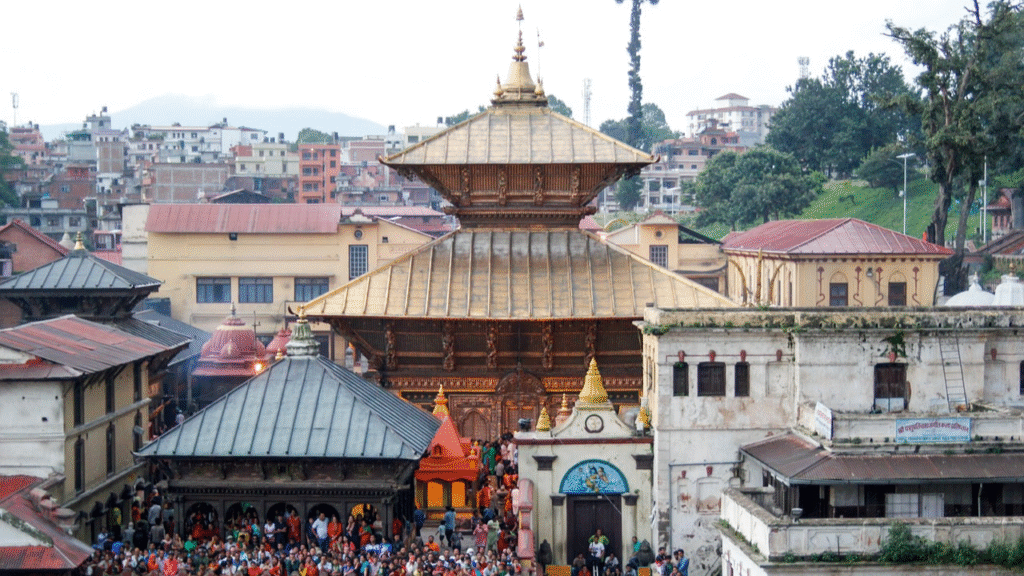Pashupatinath Temple, one of the most revered Hindu temples dedicated to Lord Shiva, stands majestically on the banks of the Bagmati River in Kathmandu, Nepal. Recognized as a UNESCO World Heritage Site, the temple attracts millions of devotees and tourists each year. It holds immense spiritual, cultural, and architectural significance, making it one of the holiest shrines in the Hindu religion.
| Temple Name | Pashupatinath Temple |
| Location | Kathmandu, Nepal |
| Deity | Lord Shiva (as Pashupati) |
| River | Bagmati River |
| Built In | Original temple believed to date back to 400 AD; present structure from 17th century |
| Architecture Style | Nepalese Pagoda Style |
| Significance | One of the holiest Shiva temples; UNESCO World Heritage Site |
| Main Festivals | Maha Shivaratri, Teej |
| Daily Rituals | Morning Abhishekam, Mahasnan, Evening Aarti |
| Entry Restrictions | Only Hindus allowed inside sanctum; foreigners can view from outside |
| Best Time to Visit | October to March |
| Nearby Attractions | Boudhanath Stupa, Guhyeshwari Temple, Swayambhunath, Thamel Market |
| Spiritual Importance | Believed to grant Moksha (liberation) when cremated on its ghats |
| Special Features | Four-faced Shiva Lingam, Arya Ghat Cremation, Bagmati Aarti |
| Managed By | Pashupati Area Development Trust (PADT) |
History and Mythology of Pashupatinath
The origins of the Pashupatinath Temple trace back to ancient times, though the exact date of construction remains a mystery. According to Hindu legends, Lord Shiva once took the form of a deer and roamed the forest near Bagmati. When the gods recognized him, they tried to bring him back to his divine duties. In the struggle, one of his horns broke and was buried. Years later, a herdsman found a shining lingam at the same spot. This marked the beginning of the Pashupatinath Temple.
The present temple structure was built in the 17th century by King Bhupendra Malla after the previous structure was destroyed by termites. However, records and inscriptions indicate that a shrine to Lord Shiva existed here as early as 400 AD.
Architectural Grandeur
The temple exemplifies Nepalese pagoda architecture, featuring two-tiered roofs made of copper and gold, intricately carved wooden rafters, and a silver-plated door guarded by Nandi, the sacred bull of Shiva. The main sanctum houses the sacred Shiva lingam, which has four faces symbolizing the different aspects of Shiva—Sadyojata, Vamadeva, Tatpurusha, and Aghora.
Surrounding the main temple are hundreds of smaller shrines, inscriptions, and temples dedicated to various deities. Notable among them are the Vasuki Nath Temple, Ram Temple, and Guhyeshwari Temple, dedicated to Goddess Sati.
Religious Significance
Pashupatinath is regarded as the head of the twelve Jyotirlingas and is one of the eight sacred abodes (Pashupata Kshetras) of Shiva. It is also believed that dying at Pashupatinath and being cremated on the banks of the Bagmati River ensures moksha (liberation) from the cycle of rebirth.
Every year during Maha Shivaratri, the temple sees an influx of over a million pilgrims, including Naga Sadhus, ascetics, and tourists. Devotees fast, chant hymns, and offer prayers, making it a grand spiritual spectacle.
Daily Rituals and Aarti
The temple follows a strict daily routine of pujas, abhishekams, and aartis. Only Hindu devotees are allowed inside the main sanctum. The day starts with the Morning Abhishekam, followed by Mahasnan (holy bath of the lingam), and Aarti performed by the head priests, who are Bhatta Brahmins from South India, specifically from Karnataka.
In the evening, the Bagmati Ganga Aarti is performed at the riverbank, similar to the Ganga Aarti of Varanasi. Priests with flaming lamps and rhythmic chants create a spiritually charged atmosphere that draws crowds from across the world.
Cremation Ghats and Spiritual Transition
The Arya Ghat, located near the temple, is a significant cremation site. According to Hindu beliefs, cremation here grants spiritual merit and liberation. The view of funeral pyres against the backdrop of chanting and flowing Bagmati offers a glimpse into the Hindu concept of life, death, and rebirth.
Cultural Significance
Apart from its religious importance, the Pashupatinath Temple plays a vital role in Nepalese culture. It hosts various festivals, cultural performances, and religious discourses. The temple’s location on the Bagmati River has led to the development of Kathmandu as a spiritual hub.
The area around the temple is also home to Sadhus, holy men who live in celibacy and meditation. Tourists often find them seated in meditative postures or engaged in spiritual discussions.
Visiting the Temple – Travel Information
Pashupatinath Temple is located about 5 km from Tribhuvan International Airport, making it easily accessible to both domestic and international travelers. Foreign nationals are not allowed inside the main sanctum but can view the temple premises and attend the aarti from across the river.
Best Time to Visit
The best time to visit is from October to March, when the weather is pleasant. Visiting during Maha Shivaratri or Teej Festival provides a more vibrant and immersive experience.
Entry and Guidelines
There is no entry fee for Indian citizens. Non-Hindus can explore the outer premises and observe rituals from designated viewing areas. Photography inside the temple is strictly prohibited. Visitors are expected to dress modestly and maintain silence inside the premises.
Nearby Attractions
There are several interesting places near Pashupatinath Temple:
- Boudhanath Stupa – One of the largest stupas in the world
- Guhyeshwari Temple – Dedicated to Goddess Parvati
- Swayambhunath (Monkey Temple) – An ancient religious complex atop a hill
- Thamel Market – A popular tourist spot for shopping and dining
Preservation and Modern Relevance
The temple underwent renovation and restoration after the 2015 Nepal Earthquake, with contributions from both local authorities and international agencies. Efforts are being made to preserve its ancient charm while making it more accessible to modern pilgrims.



